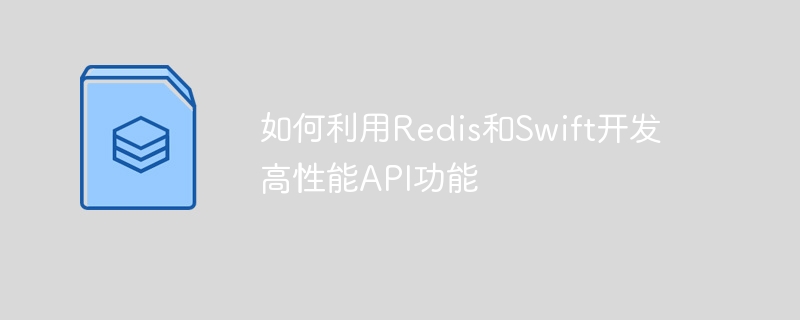
How to use Redis and Swift to develop high-performance API functions
With the rapid development of Internet technology, API (Application Programming Interface) has become an important component of various applications part. The development of high-performance API functions is one of the keys to improving user experience. This article will introduce how to use Redis and Swift to develop high-performance API functions and provide specific code examples.
1. What is Redis?
Redis (Remote Dictionary Server) is an open source in-memory database that provides rich data structures and high-performance access interfaces. The biggest advantage of Redis is its in-memory database characteristics, which enable it to achieve extremely high read and write performance.
2. The combination of Redis and Swift
Swift is a modern programming language that is widely used in iOS and macOS development. It has intuitive syntax, flexible features and efficient running speed, making it very suitable for developing high-performance API functions.
In the process of realizing high-performance API functions, Redis and Swift can cooperate with each other and give full play to their respective advantages.
3. Use Redis to implement caching function
Cache is one of the important means to improve API performance. As an in-memory database, Redis is very suitable for implementing caching functions. We can use Redis to cache some commonly used data to avoid repeated database query operations.
In Swift, we can use the Redis client library to connect and operate the Redis database. The following is a simple usage example:
import SwiftRedis
let redis = Redis()
// 连接到Redis数据库
try redis.connect(host: "localhost", port: 6379)
// 设置缓存数据
try redis.set("key", value: "value")
// 获取缓存数据
let value = try redis.get("key")
// 关闭Redis连接
redis.disconnect()Through the above example, we can see that the SwiftRedis library can be used to easily connect and operate the Redis database. We can set the cache data through the set method and obtain the cache data through the get method.
4. Using Redis to implement distributed locks
In a multi-threaded and distributed environment, how to achieve concurrency control is an important issue. Redis provides atomic operations that support distributed locks, which can help us achieve concurrency control.
In Swift, we can use Redis's atomic operations to implement simple distributed locks. The following is an example:
import SwiftRedis
let redis = Redis()
// 连接到Redis数据库
try redis.connect(host: "localhost", port: 6379)
// 加锁
let locked = try redis.setnx("lock_key", value: "locked")
if locked {
// 获取到锁,执行业务逻辑
} else {
// 未获取到锁,等待或执行其他操作
}
// 解锁
try redis.del("lock_key")
// 关闭Redis连接
redis.disconnect()Through the above example, we can see that using the setnx method of the SwiftRedis library, we can try to set a "lock_key" key-value pair in Redis. If the setting is successful, it means The lock is obtained and business logic can be executed. After executing the business logic, we can delete the lock through the del method.
5. Using Redis to implement message queue
Message queue is one of the keys to realizing high-performance API functions. Using the publish and subscribe mechanism of Redis, we can implement a simple message queue function.
In Swift, we can use Redis's publish and subscribe mechanism to implement message queues. The following is an example:
import SwiftRedis
let redis = Redis()
// 连接到Redis数据库
try redis.connect(host: "localhost", port: 6379)
// 订阅消息队列
try redis.subscribe(["channel_1"]) { channel, message in
// 收到消息,执行业务逻辑
print("(channel): (message)")
}
// 发布消息
try redis.publish("channel_1", message: "hello")
// 关闭Redis连接
redis.disconnect()Through the above example, we can see that using the subscribe method of the SwiftRedis library, we can subscribe to the messages of the "channel_1" channel. After receiving the message, we can execute the corresponding business logic. In the example, we publish a message through the publish method.
6. Summary
Using the combination of Redis and Swift, we can develop high-performance API functions. Through the caching function of Redis, we can reduce database operations and improve the response speed of the API. Through Redis's distributed lock mechanism, we can achieve concurrency control. Through the publish and subscribe mechanism of Redis, we can implement the message queue function. The above is a brief introduction and code examples of using Redis and Swift to develop high-performance API functions.
(This article only provides basic knowledge and code examples about the development of high-performance API functions with Redis and Swift. Specific practical applications require further development and optimization based on actual needs.)
The above is the detailed content of How to develop high-performance API functions using Redis and Swift. For more information, please follow other related articles on the PHP Chinese website!




